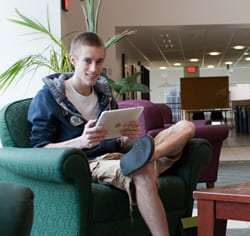 UW-Green Bay is becoming more connected than ever, thanks to an ongoing initiative that’s expanding wireless access campus-wide.
UW-Green Bay is becoming more connected than ever, thanks to an ongoing initiative that’s expanding wireless access campus-wide.
During the next year, the UWGB Wireless Project will broaden coverage to include all academic and administrative buildings, as well as student apartments and residence halls, said Diane Blohowiak, coordinator of user support for Computing and Information Technology at UW-Green Bay. Installation efforts will focus on Residence Life buildings this summer and continue elsewhere on campus in the fall. Officials hope to complete the wireless project in May of 2012.
 “It’s been on the wish list for sometime,” Blohowiak said, noting that common areas including most of the Cofrin Library and University Union already offer wireless access.
“It’s been on the wish list for sometime,” Blohowiak said, noting that common areas including most of the Cofrin Library and University Union already offer wireless access.
“More and more students are using mobile devices.
… Wireless becomes a great service for these devices, as well as for accessing e-mail or the internet or whatever. People want this constant access.”
The upgraded access comes with a few changes of which those on campus, as well as visitors, should be aware:
- For students, faculty and staff: New connection procedures took effect last month, meaning users need to configure laptop computers or other wireless devices to authenticate the ‘UWGB Wireless’ network with their campus username and password. Once this is done, Blohowiak said, users automatically will be logged in whenever they connect. Users can refer to the UWGB Wireless eHelp page for instructions.
- For guests: Campus visitors are able to use the ‘UWGB Guest’ network, which provides an unsecured wireless connection that allows a few basic internet protocols — such as http and https — according to CIT.
- For traveling students, faculty and staff: UW-Green Bay has joined the EDUROAM consortium, a wireless service that allows faculty, staff and students to access wireless networks at participating institutions using their UWGB account and password. This will support those who travel to other colleges and universities and allow individuals from participating institutions to access our wireless network when they’re here, Blohowiak said. Instructions on how to use EDUROAM and further details are available within eHelp.
The improvements to the ‘UWGB Wireless’ network also mean data now will be encrypted for greater security as they travel from computer or mobile device to wireless access points on campus. In addition, users with a device that supports the 802.11a or 802.11n wireless protocols will be able to connect and operate at enhanced network speeds.
The change is positive for all students, and particularly those who live on campus, said Glenn Gray, director of Residence Life.

“Students are very excited about this, as they have come to expect access to this kind of technology wherever they go,” Gray said. “Expanding wireless access to all residential facilities may also have contributed to what is proving to be an all-time high number of returning or continuing students contracting to live on campus this fall (2011).”
Residence Life officials predict approximately 2,025 students will live on campus during fall semester.
Whether for laptop computers or increasingly popular handheld devices, wireless connectivity is key, Blohowiak said.
“The handhelds are the future,” she said, “and the future is here.”

